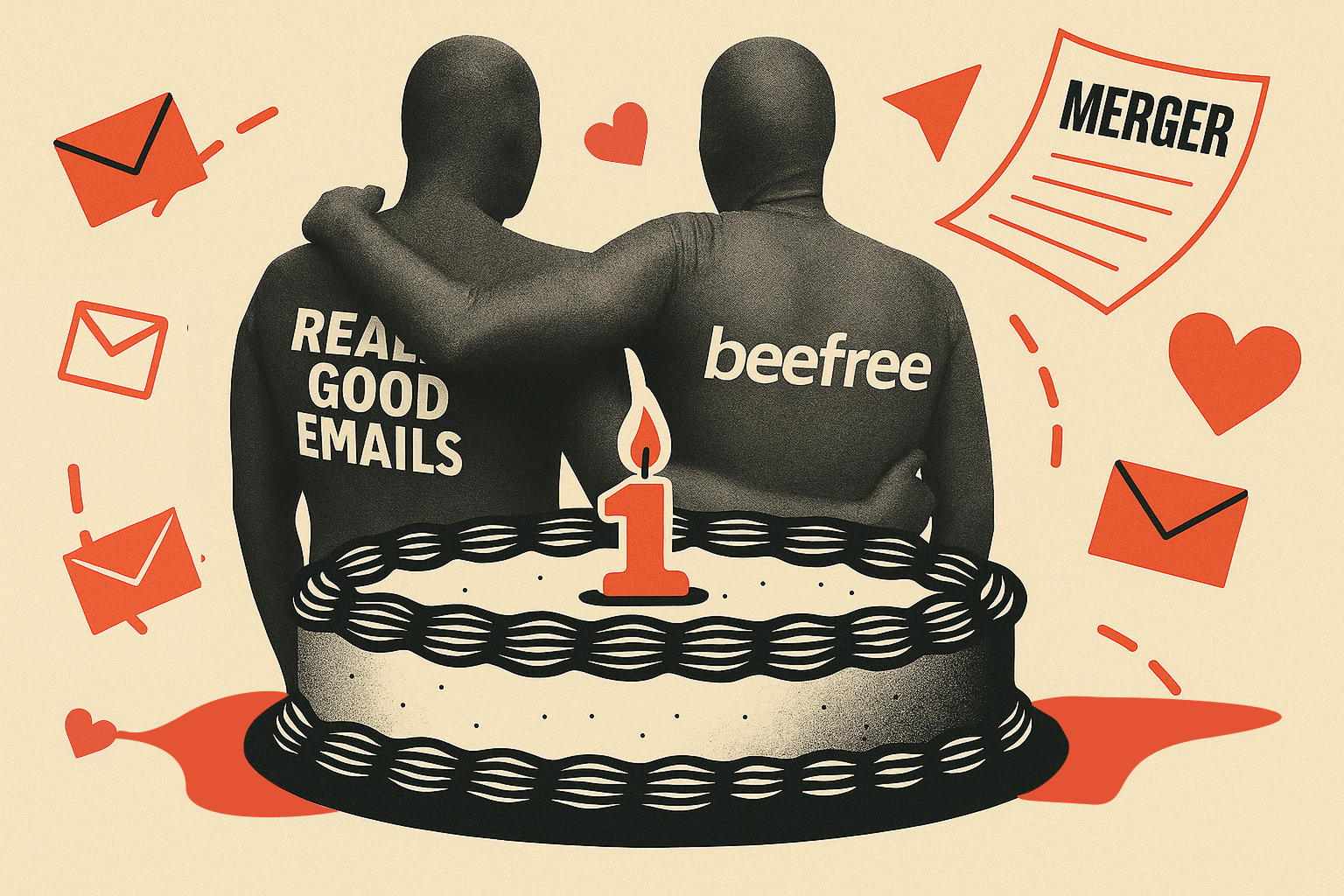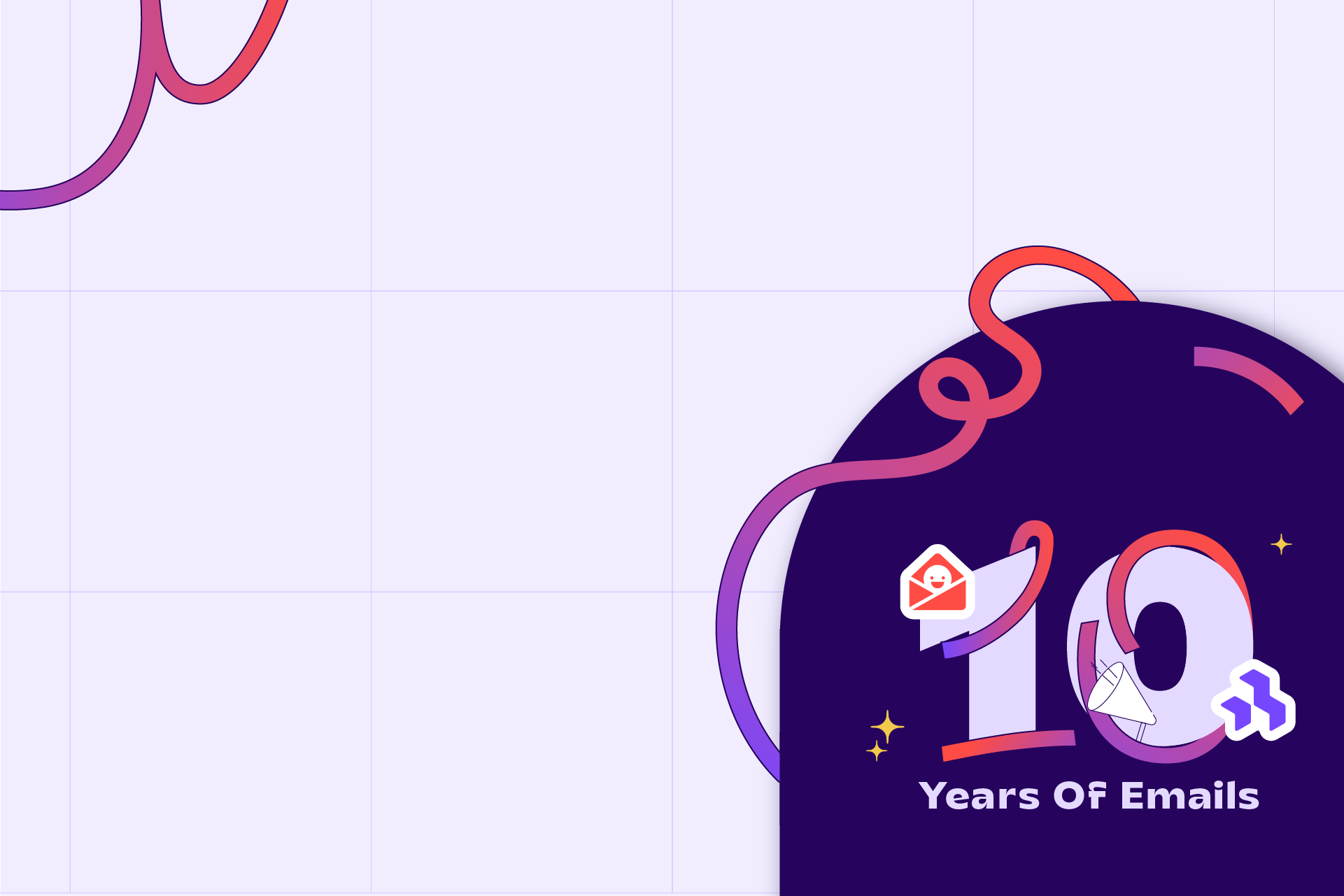Anne Wave: I am so grateful to be here. It's really exciting to be in a room of folks talking about things that I love. And when I think about the last few years I've been attending Unspam, I see many more people mention Lifecycle. That's what I'm talking about today. I'm in a lifecycle role. We had some fantastic discussions yesterday in that breakout room. I am here to talk today about the term zone of genius. I could call this talk a few different things. This could be about building the business case for boundaries. I could also call it how I do the right work. But I think I want to lead into this idea of operations, speaking up.
So, my talk today will be successful if you feel like coming away from this, you can properly diagnose for yourself or for your team whether you're doing the right work. I'll start with a quick introduction. This is my favorite headshot. Thanks, AI. This is me as a Lego. My name is Anne. I have an almost 12-year history in email over the last few years. I've done some work on changing that title from email to Lifecycle. So, I'm currently at Alma, and I am really excited to bring this idea that I formed in my early tenure there to this audience. I want to start by talking about the challenge we all feel as lifecycle marketers.
When I hear our perennial challenge, I think about the tension between a short-term win and a long-term gain. So maybe somebody in the business comes to you and says, "Oh my God, we have to send this email by Friday." Or, "There's this issue with some customers. Can we actually send an email to get that fixed?" If you're not careful, suddenly, your job and email calendar can get filled up with things that are not driving that long-term compounding evergreen strategy. Raise your hand if you've ever been personally victimized by webinar emails. What I mean by this is you think about the invites, the reminders, the thank you, the sorry, we missed you, and the ways you may be trying to deliver for all the other parts of your business.
And you're struggling to find the space for the right work. You're struggling to find the space to ensure people hear the right things from you.
And that would be about the programmatic return. So when I say programmatic, I mean those campaigns that you turn on. It's a workflow. It's things that flow through on their own. And so I just want to offer you this as I get started in my presentation. What I'm working towards—this is just a teaser. What I'm working towards is this final output. This is something that I created in about April of last year, talking about what the zone of genius of Lifecycle is.

So there's some tension here between what the business needs, what an individual marketer may want from their career, what the customer wants, and what drives revenue. So we're going to build up to this. We're going to come back to it. And where should we begin with the story? Conflict and tension are the foundation of any good story, which I want to invite you all to think about. As I speak here today, tension and conflict can be a character development. This is Tom against Jerry, and who is going to win? So, I joined my company in February of last year. I did this exercise through that. So, I'll be telling the story throughout that context. I had a great team of folks doing excellent work when I came in.
It took some time to step back and say, what are we all doing? What are we all focused on? So, you think about the inventory of work as a lifecycle marketer. You might be enabling customer-facing teams. Maybe there's a "sorry, this happened" email to let people know what to do next. There could be some issue triaging, some project management, and certainly some programmatic work. She'll come back. Weekly newsletters, a monthly roundup, new product launches, and ad hoc reporting all come together into the tapestry of what a lifecycle marketing team can do. I was spending some time thinking about whether there are themes here.
You look at the swath of work a team is doing, and I thought a few categories emerged. So, the first was enablement.
Think about a product launch email. Think about accomplishing somebody else's goal, but using email to do it. There were some ad-hocs. I've had some conversations over the last few days about how to evolve your strategy from ad hoc to programmatic. There may be a place for ad hoc, but if you're doing too much of it by the time you get to the programmatic work, you should consider a communication limit. As an example, if you set the limit that someone in your ESP can only receive two emails a week, and if you send out a good number of ad-hocs, they might never get the programmatic content.
I saw another trend here about ad hoc.

Some of it, frankly, was marketing operations work. Some of this was about building in Marketo and doing the QA and all of these amazing technical things that MOPS folks do so well. And then over here was programmatic. So she's back, she's kind of hanging out on the bottom left. As I was thinking about the scope of work here and weighing them, it was actually really heavy on the right. There is a hefty focus on enablement and ad hoc, but it is less focused and pretty light on the programmatic side. If you apply this to your scenario, you're doing some inventory of the work that your team does or that you do.
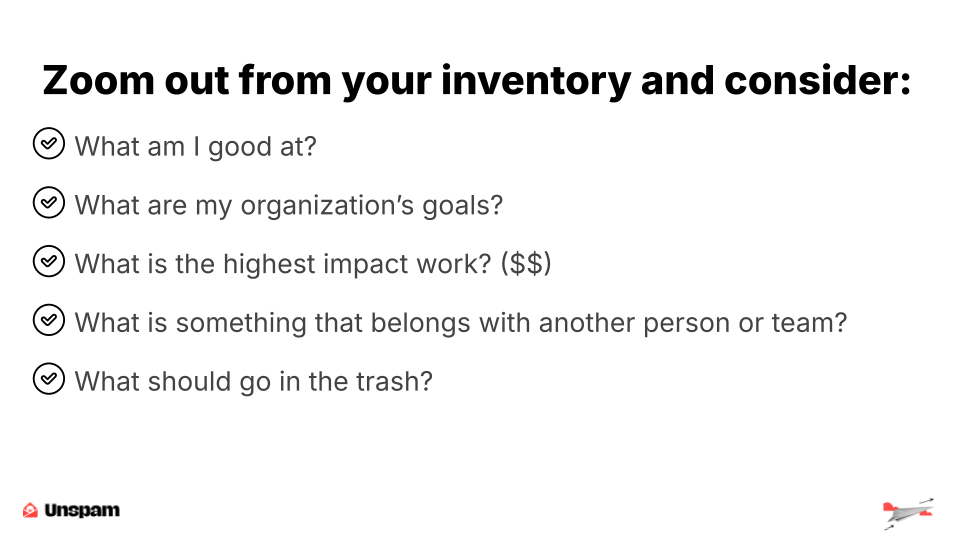
Suppose you're a team of one. I want to offer you some things to consider as you zoom out from your inventories. This is what I was thinking about. What am I good at? Why was I brought in? Who hired me and why? So, what am I uniquely good at? Keep that in mind. What are my organization's goals? There's something here that can be explicit. For example, your boss says, "Please do more of this." Some of it can be implicit, like your KPI is this. So, what are my organization's goals? Keep that in mind. What's the highest-impact work? I'm going to come back to this in-depth in the next slide. But this is about connecting your work to the dollars.
What impactful work drives the dollars for this business? How do I connect my role to what every executive cares about, which is money? What belongs with another person or another team? This happens often on a company's scale time.
Maybe you had this original plan. You get beyond that original plan. Maybe you're taking off some of those hats. Is there a place that maybe this work belongs with? Marketing operations, as I was just saying. So what's something that maybe belongs to another person or a team? And then, finally, what should go in the trash? This is also perhaps known as Kill Your Darlings.
This comes up a lot in companies at this scale.
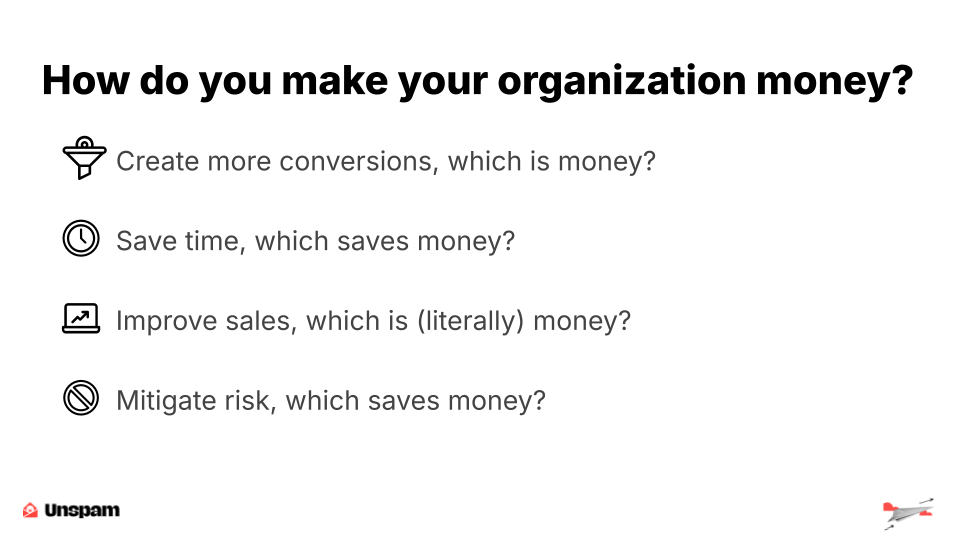
So, if you do this inventory, you take a step back and think about these things. I want to dive deeper into how you make your organization money. This slide could be a separate talk about how to write a resume. So, how do you talk about connecting your work to something that is a universal language? Maybe the KPI that you're measuring is a subscriber. Maybe it's a donor, maybe it's the amount per donor, or maybe it's a SaaS metric. But there's a fascinating exercise here when you think about what makes your organization money. I'll give you some examples. Does it create more conversions, which is money?
Does it save time, which saves money? They say time is money. Does it improve sales, which is dollars? Does it mitigate risk, which saves money? So, when you think about your role, imagine someone who is a lifecycle marketer driving revenue and conversions versus someone who is in marketing operations. We might talk about our KPIs differently, but there is a common language that we can use to reach this answer.
So this is Georgie. This is the Great British Bake Off. I'm going to take a step back into my story and talk about my inventory. I felt slightly like Georgie trying to weigh these things together. I felt the tension between this enablement, ad hoc, short-term strategy and what I know Lifecycle can deliver value for on that other side, which became pretty light. Thinking about Georgie, weighing it all, if you don't think carefully and consider what is the right work, you might become Mona.
So, it can become a tug-of-war. You want to go this way; you're trying to lead the business this way. Ultimately, these short-term or non-conversion-driving activities can drain your time, so when you think about that inventory, I guess the worst-case scenario here would be this tension and conflict that can't be resolved.
So I'm pulling this way.
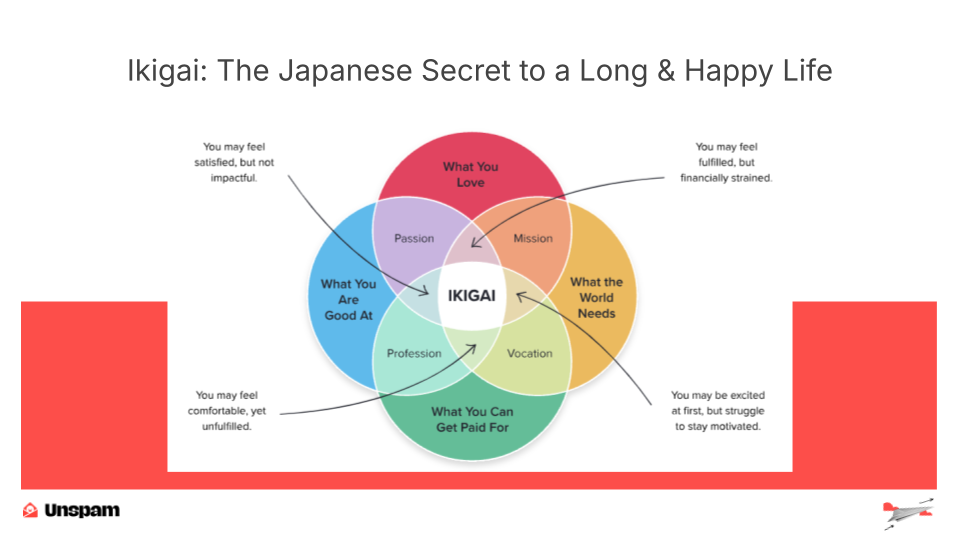
The business is pulling me that way. As I'm thinking about that, I read a book about Ikigai last year. Is anyone here familiar with this concept? A little bit, a few. You might have seen this on LinkedIn or Pinterest, or people talking about how to figure out my calling.
So there's some tension here in these concentric circles, and I think the clearest one to illustrate the point is between what you love and what you can get paid to do. I think part of that middle space might be email, but you think about what somebody loves to do might not always drive dollars. You might not be able to afford your life just by reading. I love to read. That's not going to pay my bills. I was thinking about the tension between these ideas and applied that to the inventory exercise that I had done. I'll start with a simple example.
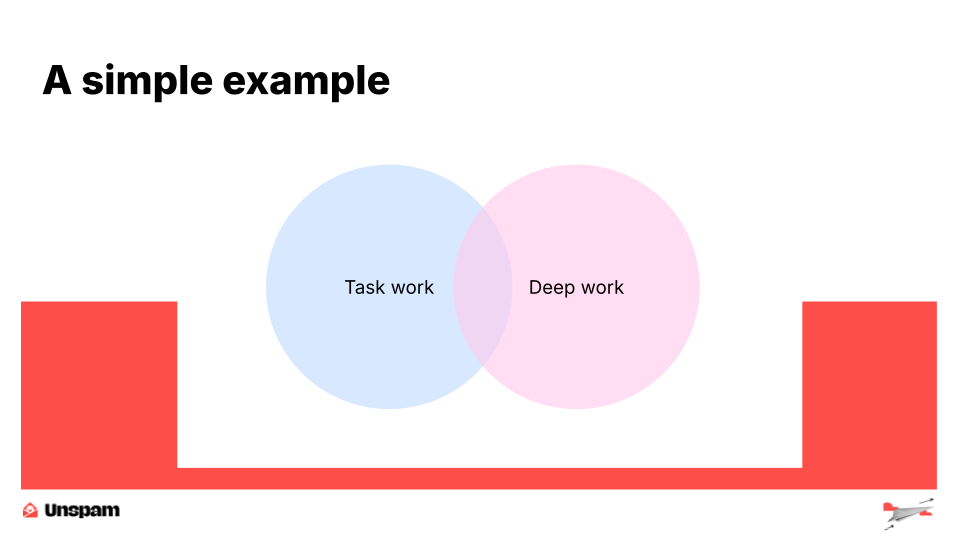
There is some tension here between task work and deep work. Think about how you might block your calendar to get 30 minutes in between meetings. You might not be coming up with your next great idea.
But when you think about the tension between these and focus on that area in the middle, is there something that's actually driving both? So, I wanted to use a simple example to illustrate that. It doesn't have to be four concentric circles. It doesn't have to be Lifecycle in the center. But when you think about the tension in your job and where you feel like you're pulling one way and maybe your company or manager is pulling another, something like this might help get you on that track. So, this is my zone of genius. I have a few layers. This is the simplest. I was thinking about this. I was socializing with some folks last year. Naomi was one of them. Thank you, my friend. In the Lifecycle world, there is this common tension between what supports revenue goals, what the business wants to have happen, and what the customer wants.
Those might not always be the same thing. Sometimes, the business needs to issue a terms and conditions update. That does not affect revenue goals, and it might not even really be what the customer wants. So, I think this top area feels like, what are we talking about when we say Lifecycle? What does that mean? And then this bottom green area is my favorite. So I lead a team, and I think about how to make sure that these people still want to work here. How do I make sure that they have the most excellent, amazing experience in Lifecycle so that they want to keep coming back? These four things layered on top of each other give us that magic middle, that secret sauce of doing Lifecycle the right way.
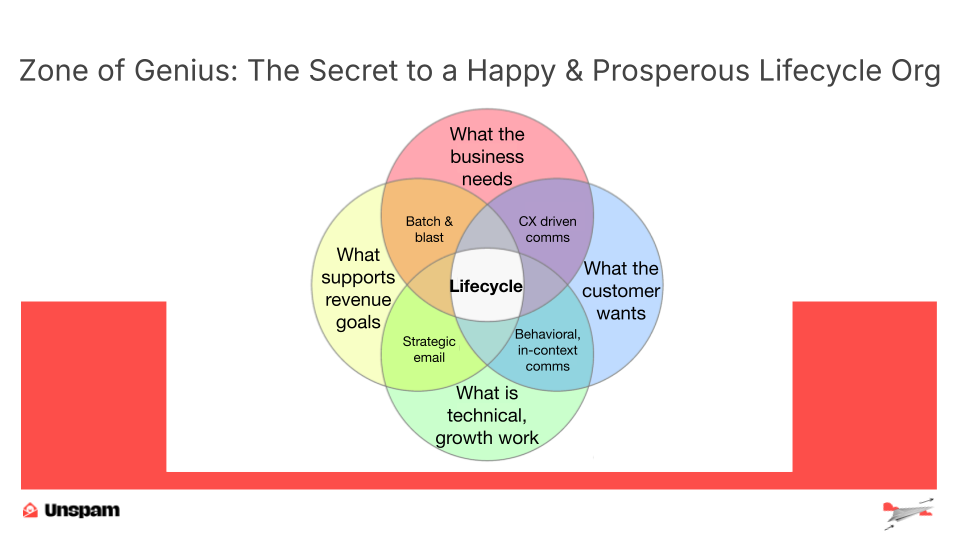
In my second layer, I was thinking, what are these things? How do I translate this even further? So what supports revenue goals is kind of abstract. What the customer wants, I don't know. But I have some additional layers here. So, between what the business needs and what supports revenue goals, batch and blast maybe. I'll talk more about that in a second. But we think about what technical growth work is and then what the customer wants. There's a nice marriage between what in-context communication is and what works. So I was thinking, extending this thought exercise, what is one layer deeper? And then, finally, this is my last layer, these circles that are just outside of one.

So, I was just talking about batch and blast. On the left side here, I have that the customer deserves better. So let's look closely at the circle. We are in three categories on the left, but we are distinctly outside of what the customer wants. So, in this area, what is happening? This is the land of diminishing returns. This is where you might exhaust your audience so much that they unsubscribe. This is a considerable risk when businesses do ad hoc work repeatedly. You will not always see the same returns there. So, this is an opportunity to highlight if this is the pain in your organization. This is an opportunity to highlight, as I said earlier, my favorite, this green area.
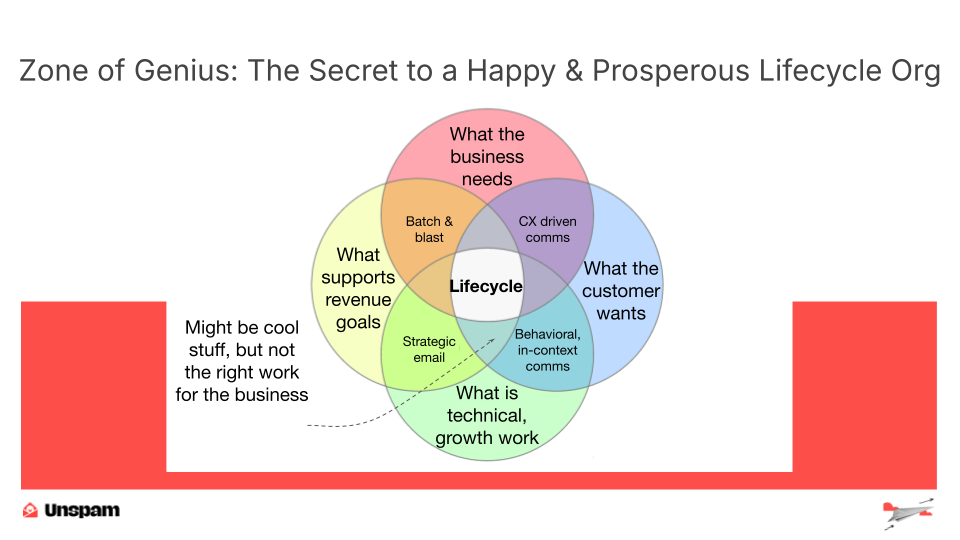
I think about the company I'm at right now, Alma, in the mental healthcare space. For example, an email marketer might want to do some cool stuff, like a highly interactive email, that our audience probably doesn't care about. So this is about ensuring that the work you're doing that's cool is also cool to the business. So you're not just designing something beautifully and amazingly.
Maybe a text-based email would work. How to use this with the team. So I had this brain concoction, took it to my team, and the exercise I did was, where on the map would you place your work today? It was a really nice exercise to get into the mindset of what your team thinks they're doing and whether they think it's important.
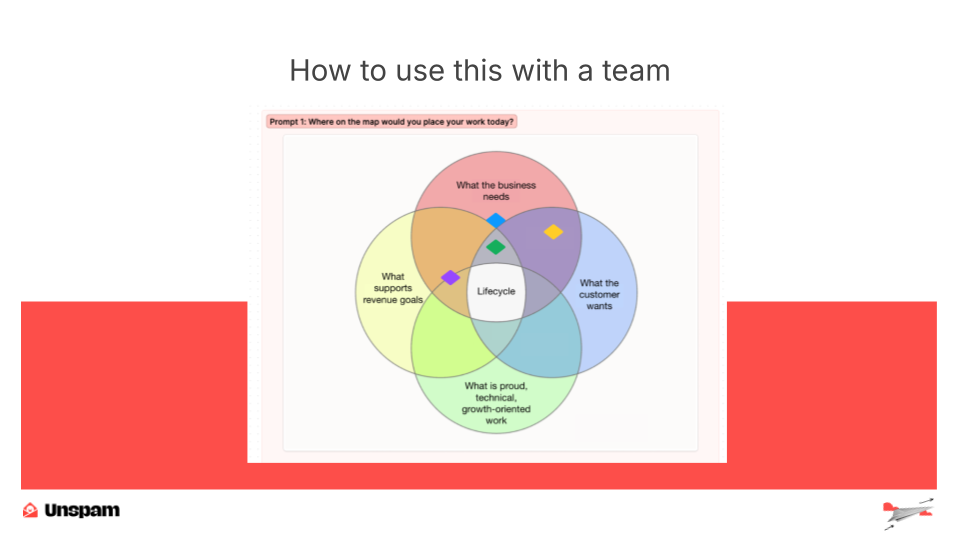
So, some really interesting learnings came out of here. I'll circle two of them. The first on the left, this person with the purple diamond, thinks that what they're doing is not at all what the customer wants. That's a really interesting insight into how they perceive the value of their deliverables and how aligned they feel with what the customer wants. This is a fascinating insight. On the other hand, somebody feels like what they're doing is torn between what the business needs and what the customer wants, but it does not support revenue goals. It does not feel like growth-oriented, proud, excellent-experience work. Something interesting about this person is that I would think about their job satisfaction, whether they still want to be here if they feel like their work is not driving revenue, and what they believe is the value of it.
So, think about how this exercise can teach me a lot as the person leading this team and talking about how to retain great employees. Okay, so now what? Maybe we did this exercise. We have these concentric circles for our application. What do you do now? What did I do? I went to my manager and talked about it. I said, you know what? I think what you all want me to do is something different from what our team is focused on. Mainly, I spoke to my head of department. Whoever the actual decision maker is on your part of the business, this is about selling it to them. This is about naming the trade-offs and the risks if you do or don't do it.
This is about using the correct language to speak their language. My team doesn't want to change this overnight without letting anybody know. So this is about bringing folks along with you. Finally, my peers. Part of this is if you're holistically changing the strategy from ad hoc to programmatic. How do you tell other people how to work with you? How do you set expectations about what you're uniquely good at and how you drive conversions or money, mitigate risk, and save time? So, we'll discuss how to use this map with your manager. The first one is connecting the dots on impact. I have two ideas here. As an example, let's say you're a designer or a developer, and you're thinking, why does this apply to me? Imagine that you spin up an email design system. Instead of having to do something for the first time every time, you're saving time not only for your team by not designing over and over again.
You're also saving time for those who may build those into blocks in the ESP. So, connect the dots between what you're doing and the impact of that work. And the way you do that is by talking about money. If you're talking about Lifecycle and the drive versus this time savings, connect the dots on impact. Secondly, you have to name your trade-offs. Your manager might look like this when you first talk about it. Yeah, I'm down. Well, no, actually. Now that I'm thinking about it. So, when you're talking about naming trade-offs, this is about making sure that folks go in aware of what you're talking about getting rid of and what you're doing more of.
Using your map with your manager, make sure you're talking about what they're signing up for so they understand what you're communicating. Finally, this is such a happy baby because you brought solutions. When you're talking to a manager and maybe proposing a shift to your job scope or your team's responsibilities, just saying you want something to be different probably won't get you the outcome you're hoping for. So, if you bring a solution and you're using your manager's language to do that, they're going to be pretty happy. I want to take a little bit of an elbow off of this conversation and talk about one of my favorite things: the levels of helpfulness scale. An HRBP taught me this when I was pretty young, and I will never forget it.

The helpfulness scale is simple. I'll run you through it quickly. The first level is "I have a problem." The second is "I have a problem, and here are some solutions." The third is "I have a problem. Here are some solutions. I think this is the best one because..." and then finally, "There was a problem. Just so you know, I made this choice. Now it's fixed." My friend Karen Walker will tell us which of these levels is most appropriate for this zone of genius exercise. I'm going to say level three.
I have a problem. Here are some solutions. I recommend this one because you cannot, on your own, change the entire scope of your job or the focus of your team.
What you're really presenting to a manager is an opportunity. I have this problem. I'm noticing we're spending a lot of time here. I think some solutions could be... and I recommend using this one because you can connect that back. So, I will talk to you about how to do this. The first thing to remember when making a case to your manager is that you can't be too presumptuous. You cannot walk into a room and just tell them how it is. There is some subtle art to explaining why they should listen to you, why this is important, and how it relates to their KPIs. So, don't be too presumptuous.

We're coming in open-minded and presenting them with information. Sometimes, I think about the people closest to a problem. I'm close to specific issues. I'm not close to all of them. I would expect the folks I work with to be able to articulate to me, "Just so you know, this is not working the right way," or "I just wanted you to know this is happening." It is your job, as someone close to your problems, to communicate what those are and make sure your manager knows. If they're expecting you to deliver a KPI of conversions, but you've been executing on the ad hoc strategy instead, they're going to ask you at the end of the year what happened to the KPI you were signed up for.
On the second point, know your audience. We're all marketers here. I have two suggestions for you. First, use the voice of the customer data. What I mean is say the words your manager has said. You hear them talk, you understand what's important to them, and you say it back to them. Use that voice of the customer. Here, your manager is the customer. Make sure you're speaking the same language. Second, understand what is valuable to their part of the business. What are they trying to drive? What are the KPIs that their team ladders up to? This is about making sure the language you're speaking connects to the priorities they have. The last thing is something we've all probably heard before. You want to talk about the benefits, not the features. It's not about all of these shiny bells and whistles. It's about what those bells and whistles let you achieve. So, instead of saying, "This problem works this way because of this," focus on the ideal outcome and speak in those terms. I wanted to bring an example of a level three that I would use in this scenario.
Something like, "I've been noticing that these folks are spending a lot of time on X. It is increasingly taking away from our ability to do Y, which is threatening our ability to deliver Z at the end of the year, which I know you care about because that's our team's goal. If nothing else changes, we will have to do this. I recommend we invest half of this time in it instead. It helps us achieve B faster. We could deliver this by then. Do you have any concerns?" I think this is a really nice example of level three. There's a problem. Here are some solutions. This is the one I recommend. And I think about it. What I am expecting to hear from the folks on my team, what I want to hear from people, is, I don't think this is working, right? I think this is what I want to give you all—permission to speak up and say something about this doesn't feel right. Something about this is too focused over here.
Wow, this is really taking up a lot of time. If somebody came to me with this level three example, I would definitely have an idea of the next part of the conversation I would want to have to bring all of this together. We have begun discussing Tom and Jerry and tension and conflict as the center of your thought exercise. So, where is something you want to focus on over here, but you're feeling pulled in this other direction? Then, we talked about how to take your inventory of work and connect it to what makes your organization money. When you do that exercise and think about it, is it about saving time, mitigating risk, more conversions, and more sales? For example, I didn't list what takes your time away from that.
So, you think about that tension between a task job and a deep job. What keeps you from that deep work job is probably an example of something you should reassess. And then, finally, what do you do with this? Market your findings where you need to. This might be to different types of audiences. It might be to the folks on your team, your friends, and your products. It might be to your manager or their manager. The idea here, especially as you're talking up in the organization, is that you want to present solutions and talk about the trade-offs. You never want somebody to say yes and not understand that that implicates this other part of the work. But if you're connecting all this to, how does my job make folks money, how do I defend my employability, how do I ensure I have a role in this organization over time, you want to focus on the right work. That's it for me. If you want to talk about this, you can find me on Email Geeks all the time.
I love that place. I will chat with you about it. If you want to talk to me over email, you can do that, too. I'm just so grateful to be here. Thank you so much.
